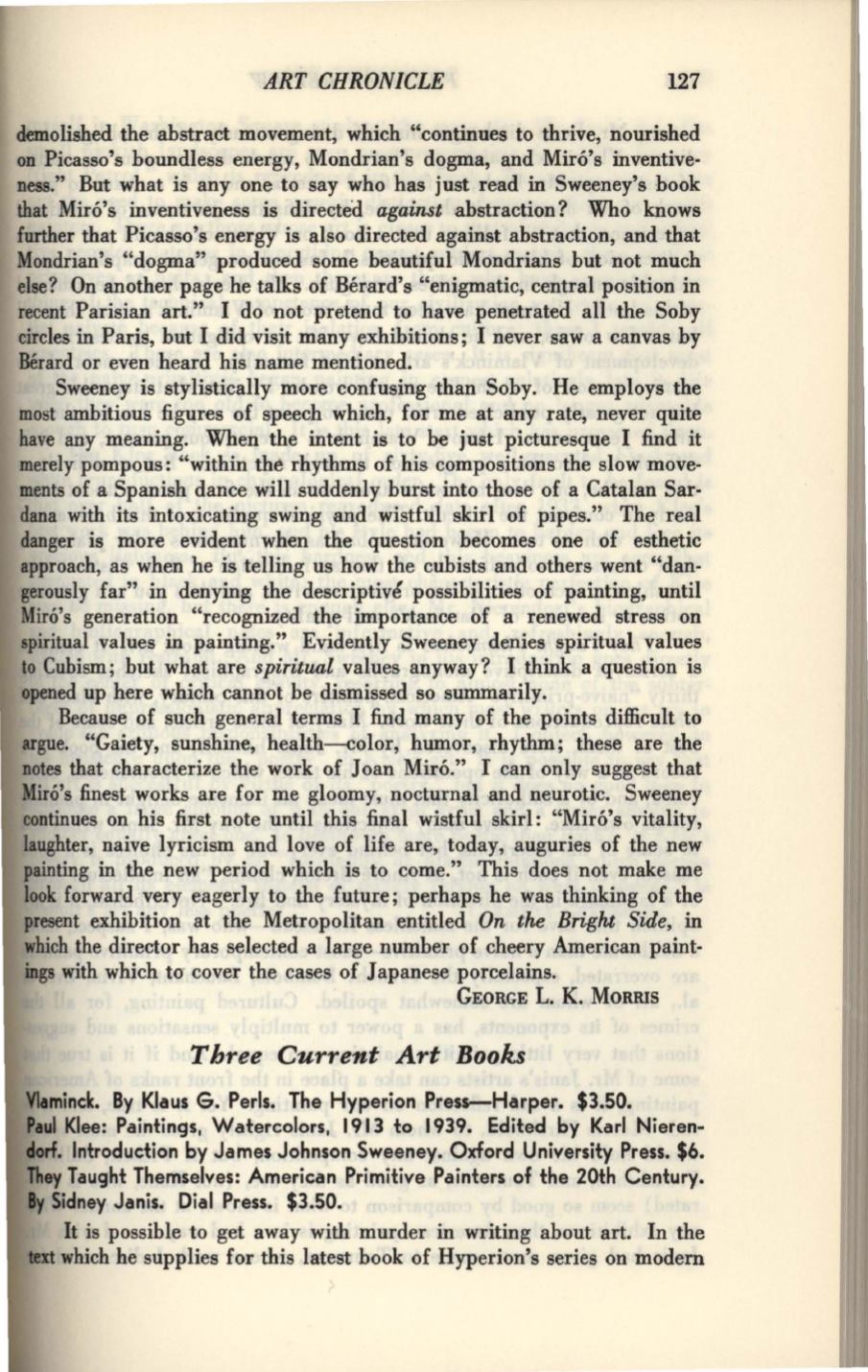
ART CHRONICLE
127
demolished the abstract movement, which "continues to thrive, nourished
on Picasso's boundless energy, Mondrian's dogma, and Miro's inventive–
ness." But what is any one to say who has just read in Sweeney's book
that Miro's inventiveness is directed
against
abstraction? Who knows
further that Picasso's energy is also directed against abstraction, and that
Mondrian's "dogma" produced some beautiful Mondrians but not much
else? On another page he talks of Ber·ard's "enigmatic, central position in
recent Parisian art." I do not pretend to have penetrated all the Soby
circles in Paris, but I did visit many exhibitions; I never saw a canvas by
Berard or even heard his name mentioned.
Sweeney is stylistically more confusing than Soby. He employs the
most ambitious figures of speech which, for me at any rate, never quite
have any meaning. When the intent is to
be
just picturesque I find
it
merely pompous: "within
th~
rhythms of his compositions the slow move–
ments of a Spanish dance will suddenly burst into those of a Catalan Sar–
dana with its intoxicating swing and wistful skirl of pipes." The real
danger is more evident when the question becomes one of esthetic
approach, as when he is telling us how the cubists and others went "dan–
gerously far" in denying the descriptive possibilities of painting, until
Miro's generation "recognized the importance of a renewed stress on
spiritual values in painting." Evidently Sweeney denies spiritual values
to
Cubism; but what are
spiritual
values anyway? I think a question is
opened up here which cannot be dismissed so summarily.
Because of such general terms I find many of the points difficult to
argue. "Gaiety, sunshine, health--color, humor, rhythm; these are the
notes that characterize the work of Joan Miro."
I
can only suggest that
Miro's finest works are for me gloomy, nocturnal .and neurotic. Sweeney
continues on his first note until this final wistful skirl: "Miro's vitality,
laughter, naive lyricism and love of life are, today, auguries of the new
painting in the new period which is to come." This does not make me
look
forward very eagerly to the future; perhaps he was thinking of the
present exhibition at the Metropolitan entitled
On
the
Bright Side,
in
which the director has selected a large number of cheery American paint–
ings
with which to cover the cases of Japanese porcelains.
GEORGE
L.
K.
MoRRis
Three Current Art Books
Vlaminck. By Klaus G. Perls. The Hyperion Press--Harper. $3.50.
Paul
Klee: Paintings, Watercolors, 1913 to 1939. Edited by Karl Nieren–
clorf.
Introduction by James Johnson Sweeney. Oxford University Press. $6.
lltey
Taught Themselves: American Primitive Painters of the 20th Century.
Jy
Sidney Janis. Dial Press. $3.50.
It is possible to get away with murder in writing about art. In the
1elt
which he supplies for this latest book of Hyperion's series on modern


